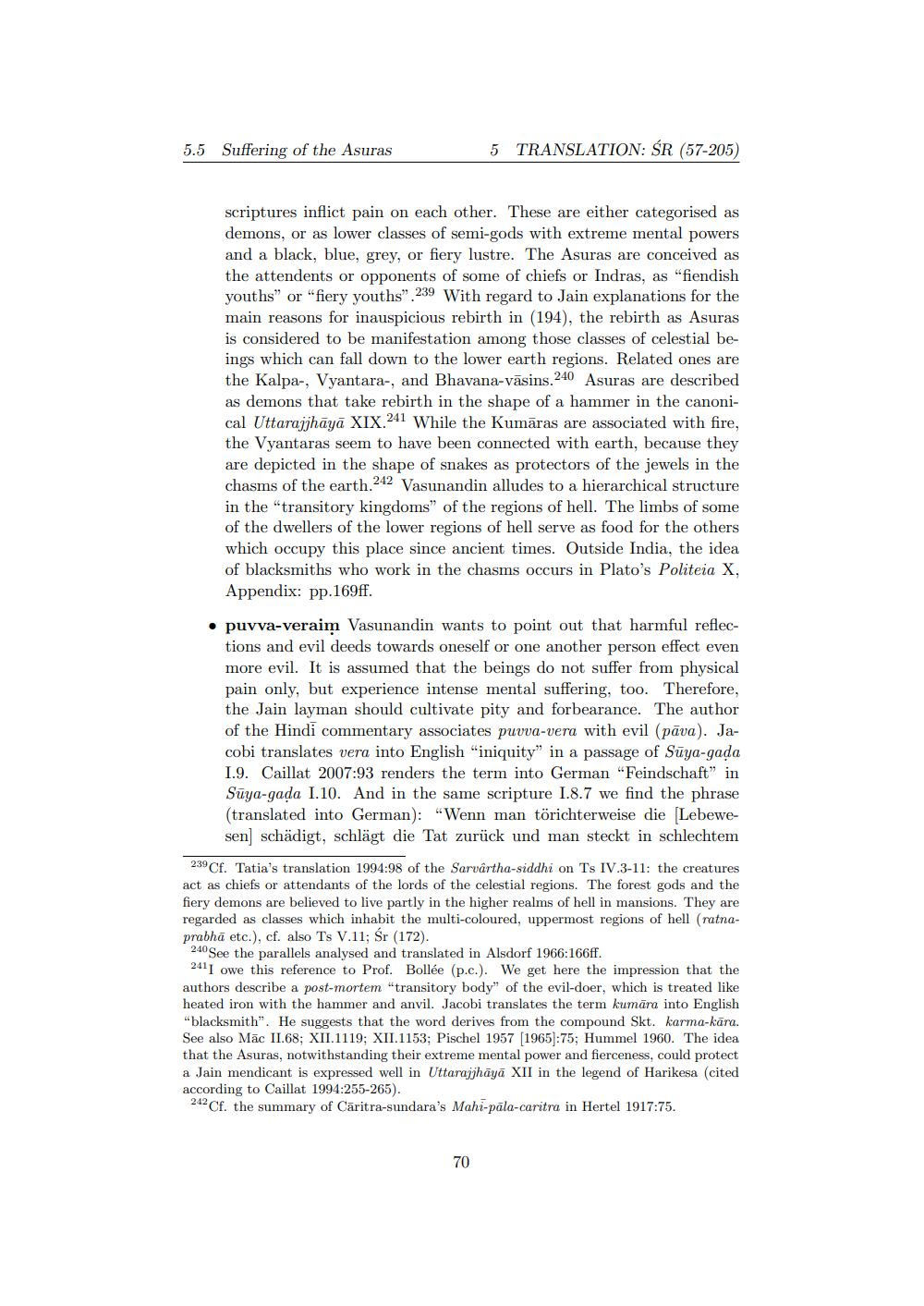________________
5.5
Suffering of the Asuras
5 TRANSLATION: ŚR (57-205)
scriptures inflict pain on each other. These are either categorised as demons, or as lower classes of semi-gods with extreme mental powers and a black, blue, grey, or fiery lustre. The Asuras are conceived as the attendents or opponents of some of chiefs or Indras, as "fiendish youths" or "fiery youths". 239 With regard to Jain explanations for the main reasons for inauspicious rebirth in (194), the rebirth as Asuras is considered to be manifestation among those classes of celestial beings which can fall down to the lower earth regions. Related ones are the Kalpa-, Vyantara-, and Bhavana-vāsins.240 Asuras are described as demons that take rebirth in the shape of a hammer in the canonical Uttarajjhāyā XIX.241 While the Kumāras are associated with fire, the Vyantaras seem to have been connected with earth, because they are depicted in the shape of snakes as protectors of the jewels in the chasms of the earth.242 Vasunandin alludes to a hierarchical structure in the "transitory kingdoms" of the regions of hell. The limbs of some of the dwellers of the lower regions of hell serve as food for the others which occupy this place since ancient times. Outside India, the idea of blacksmiths who work in the chasms occurs in Plato's Politeia X, Appendix: pp.169ff.
• puvva-veraim Vasunandin wants to point out that harmful reflec
tions and evil deeds towards oneself or one another person effect even more evil. It is assumed that the beings do not suffer from physical pain only, but experience intense mental suffering, too. Therefore, the Jain layman should cultivate pity and forbearance. The author of the Hindi commentary associates puvva-vera with evil (pāva). Jacobi translates vera into English "iniquity” in a passage of Suya-gada 1.9. Caillat 2007:93 renders the term into German "Feindschaft" in Suya-qada 1.10. And in the same scripture 1.8.7 we find the phrase (translated into German): "Wenn man törichterweise die [Lebewesen schädigt, schlägt die Tat zurück und man steckt in schlechtem
239 Cf. Tatia's translation 1994:98 of the Sarvártha-siddhi on Ts IV.3-11: the creatures act as chiefs or attendants of the lords of the celestial regions. The forest gods and the fiery demons are believed to live partly in the higher realms of hell in mansions. They are regarded as classes which inhabit the multi-coloured, uppermost regions of hell (ratnaprabhā etc.), cf. also TS V.11; Sr (172). 240 See the parallels analysed and translated in Alsdorf 1966:166ff. 2411 owe this reference to Prof. Bollée (p.c.). We get here the impression that the authors describe a post-mortem "transitory body" of the evil-doer, which is treated like heated iron with the hammer and anvil. Jacobi translates the term kumāra into English "blacksmith". He suggests that the word derives from the compound Skt. karma-kāra. See also Māc II.68; XII.1119; XII. 1153; Pischel 1957 (1965):75; Hummel 1960. The idea that the Asuras, notwithstanding their extreme mental power and fierceness, could protect a Jain mendicant is expressed well in Uttarajjhāyā XII in the legend of Harikesa (cited according to Caillat 1994:255-265). 242Cf. the summary of Caritra-sundara's Mahi-pāla-caritra in Hertel 1917:75.




